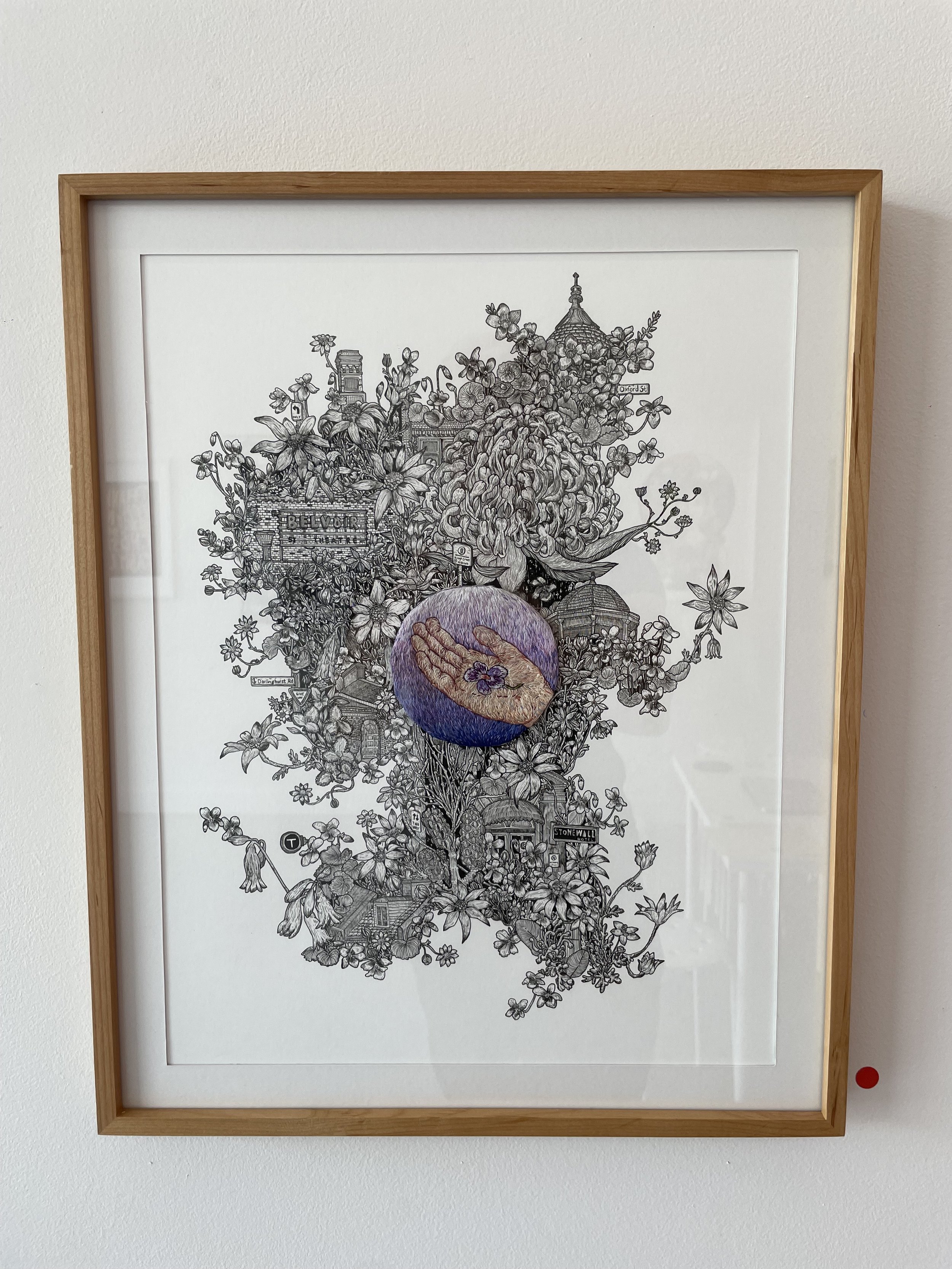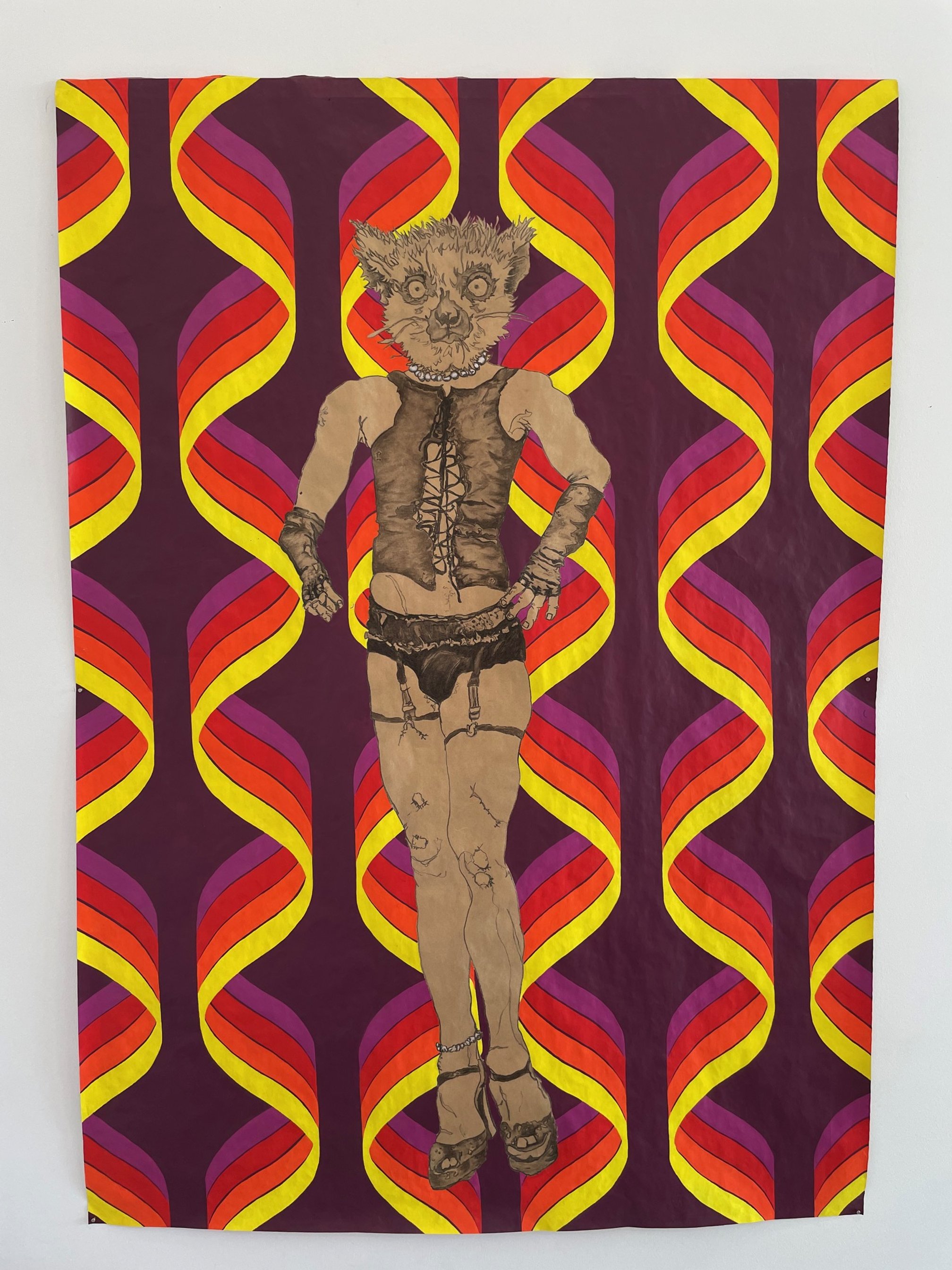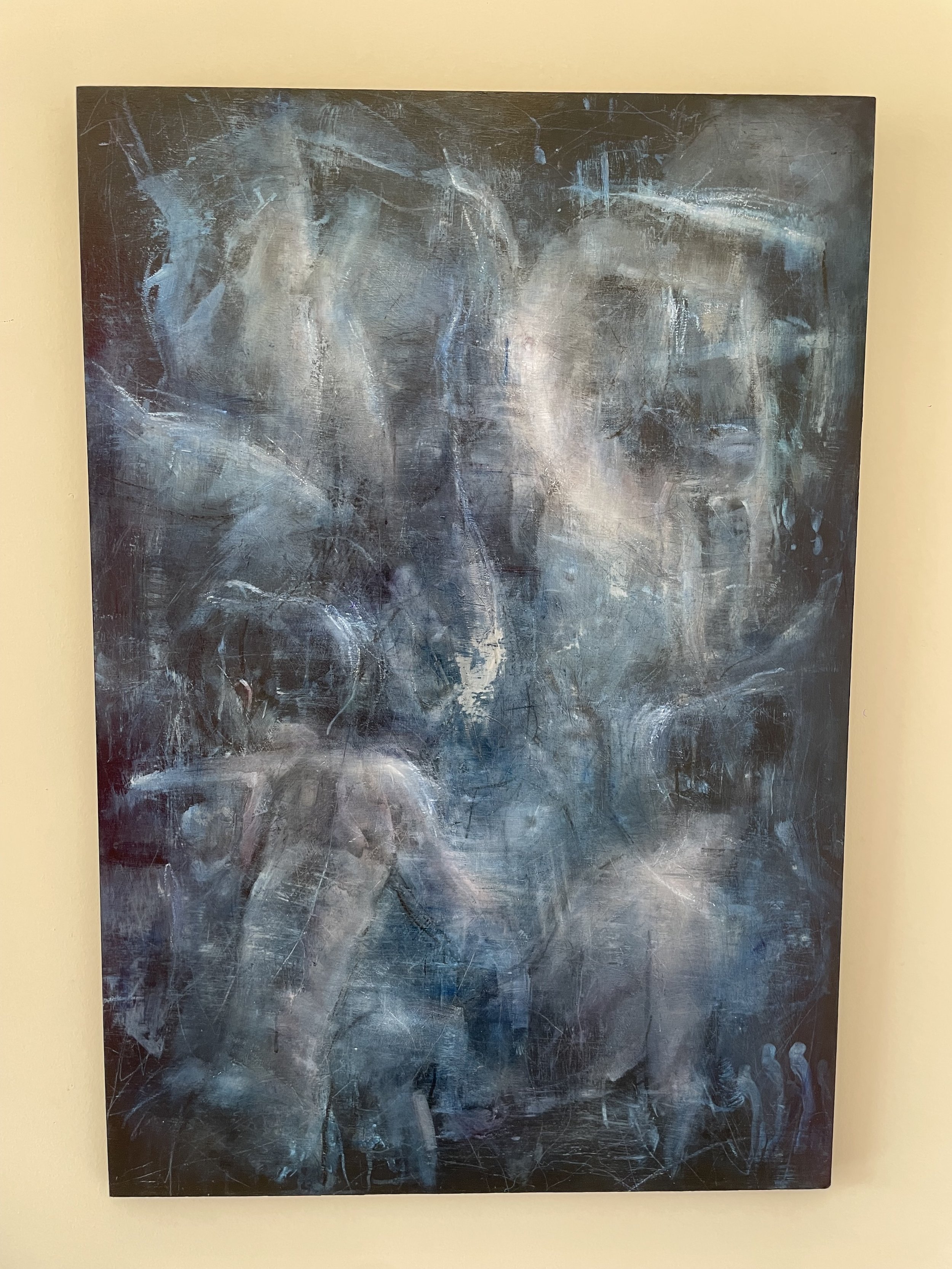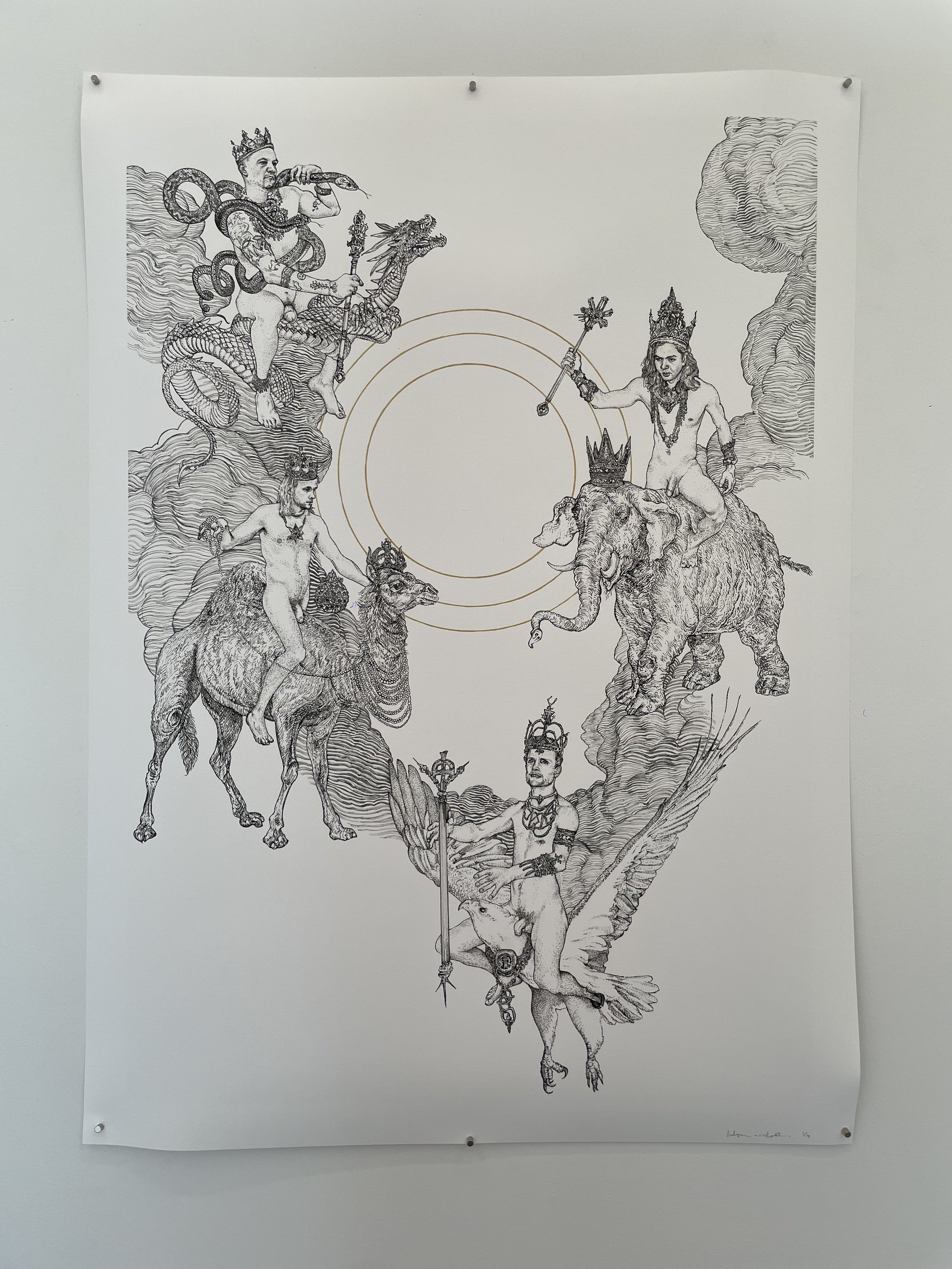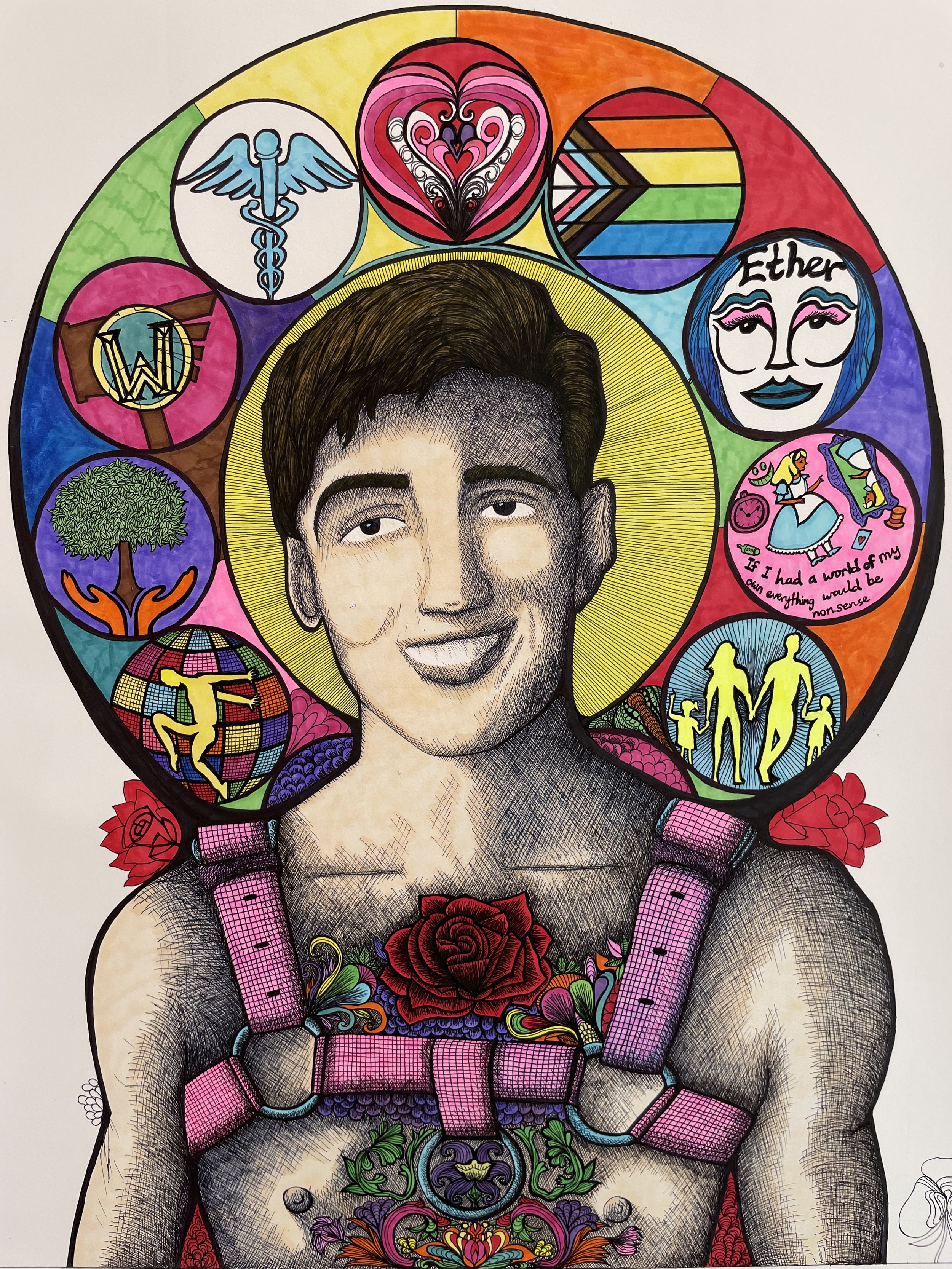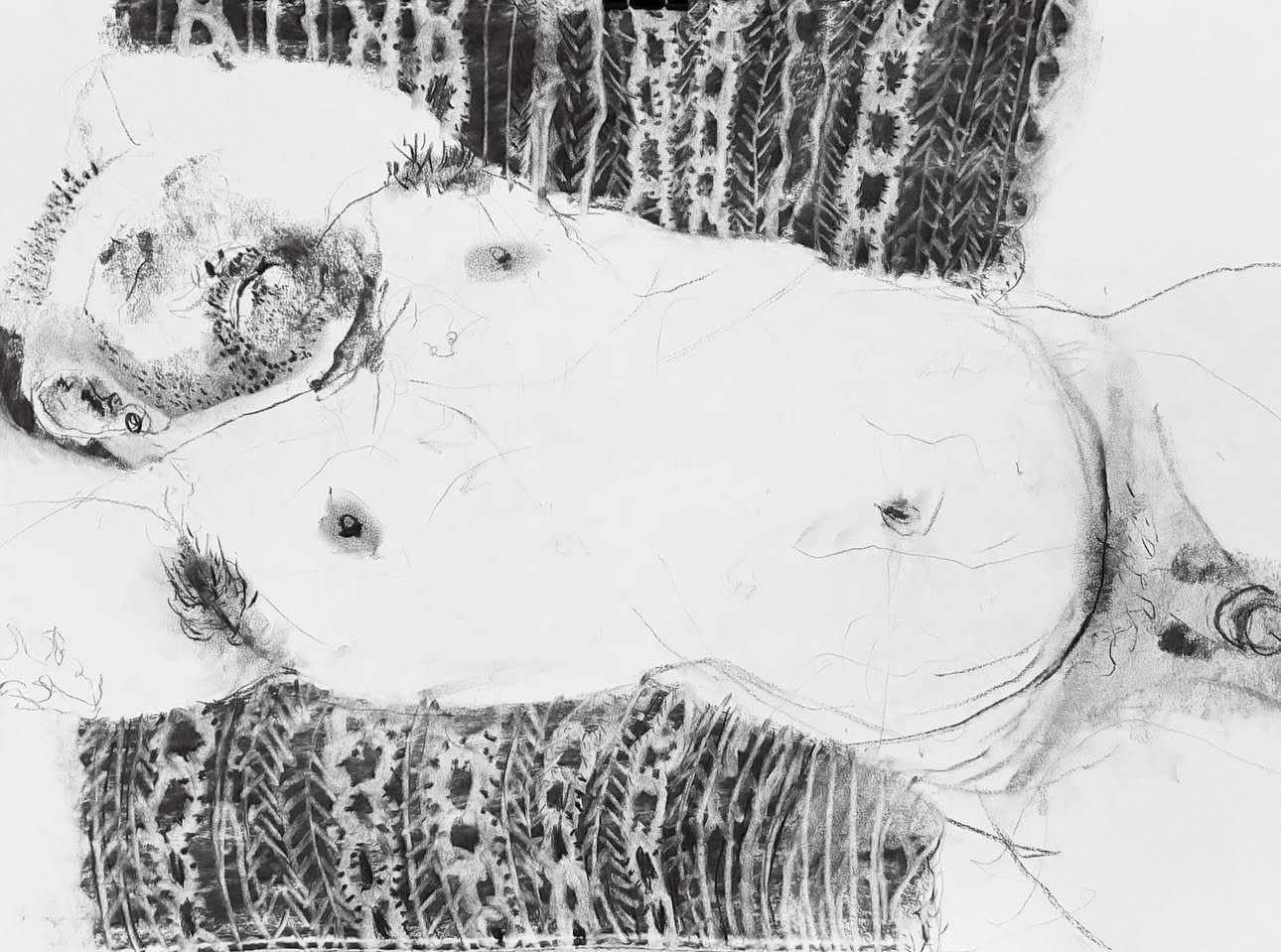Group Show / QUEER DRAWING
Thursday 6 February - Sunday 2 March 2025
To coincide with the annual Sydney Gay and Lesbian Mardi Gras in February 2025, DRAW Space will present QUEER DRAWING, which contemplates the profound connection between drawing and queerness—presenting drawings by 20 queer and ally-identifying artists, each drawing a window into the lived experience of queerness in all its diversity. Queerness is revealed in lines, shadows, and mark-making.
QUEER DRAWING is part of the official 2025 Sydney Gay and Lesbian program: https://www.mardigras.org.au/event/queer-drawing/
Opening 6-8pm Thursday, 6 February, during the first week of Mardi Gras and again on Saturday, 15 February, from 6-8 pm. With artist talks on Saturday the 8th of February 2-4 pm. Join the artists and DRAW Space team to celebrate.
Drawing is an inherently intimate act at the genesis of thought. It requires unique ways of seeing, often revealing what is hidden. Similarly, queerness embodies the idea that the personal is political; it represents a distinctive way of being and seeing, often hidden in history. In this exhibition, queerness serves as an inclusive identity for the LGBTQIA+ community and a fluid term for artistic expression, style, content, and concept.
Drawing is an act of close observation that finds a parallel in queer perception, a finely tuned awareness of subtleties in apparency, dress, and demeanour to recognise queerness in others. Like a sketch being erased and redrawn, so too, queerness exists as a state of constant becoming—forever reimagined, challenged, and lived. By translating a queer gaze through drawing, hidden worlds are revealed.
Curated by queer drawing artist Jeremy Smith, QUEER DRAWING incorporates a variety of approaches, from intricate observational sketches to bold, abstract gestures. Collectively, they explore themes of love, identity, community, and resistance. Through drawing, the participating artists make visible the intersections of their queerness with the broader cultural, social, and political landscapes. Each of the 20 artists invites you into their own unique personal queer world.
QUEER DRAWING features the work of:
Herk Alexander
Liz Bradshaw
Jack Buckley
Jodi Clark
Tango Conway
Jake Alexander Cruz
Scott Elk
Gareth Ernst
Dan Gladden
Keroshin Govender
Kim Leutwyler
Samuel Luke
Jeff McCann
Andrew Nicholls
Graham Robertson
Kurt Schranzer
Michael Simms
Jeremy Smith
Luke Thurgate
Yiorgos Zafiriou
Download the exhibition room sheet here.
The Queerness of Drawing
Exhibition essay by Jeremy Smith
Drawing is one of our most intimate acts. An immediate, raw, and honest act of revelation. To draw someone or something is to seek to know them/it deeply. Drawing visualises what lies hidden within. It begins at the genesis of our thoughts, made visible through hand and eye motions, translating the essence of what we feel, see, and love. Queerness, much like drawing, reveals the truth of who we are. To draw and to be queer is to visualise what the world makes invisible. Learning to draw is to learn to really see the world as it is and can be. As drawing requires close observation so too the queer gaze is to see a subterranean world submerged in the margins. Queer people learn a finely tuned awareness of subtleties in apparency, dress, and demeanour to recognise queerness in others. Like a sketch being erased and redrawn, so too, queerness exists as a state of constant becoming, forever reimagined, challenged, and lived.
In a world and time where queerness is often erased, QUEER DRAWING brings it to the forefront. At its core, the exhibition examines the profound link between the act of drawing and the intimacy, fluidity, and revelation found within queerness. In this exhibition, queerness serves as both an inclusive identity for the LGBTQIA+ community and a fluid term for artistic expression, style, content, and concept. Each of the artists I curated into this exhibition, through expanded drawing, invites you into their own unique queer landscape. Spanning a variety of mediums and approaches from intricate observational sketches to bold, abstract gestures, the act of drawing becomes more than a medium of artistic expression. Drawing becomes a method of reclamation, a tool for honesty, and an exploration of love, desire, identity, community, and resistance.
In the following section, I will discuss the common themes of the 20 artists. These themes are grouped under several overarching topics that explore reclaiming history, queer spirituality, fluidity of gender, the queer body, personal narratives, as well as queer family and love. Collectively, these themes provide insights into diverse queer experiences, each characterized by a unique intersection of identity, medium, and mark-making.
Historical Reclamation and Resistance
Several artists in this exhibition turn to the past, engaging with and subverting traditional historical narratives. Through the act of drawing, they challenge the structures that have historically erased or attacked queer people. Liz Bradshaw’s evocative text-based drawings interrogate evolving language of queerness through historical insults hurled at queer people such as Nancy Boy, Bent, and Mary. Employing mirroring and inversion, Bradshaw counters dominant histories, challenging this violent marginalisation embedded in history. In another text-based work, Carpet Burn, Yiorgos Zafiriou playfully responds to Leo Bersani’s seminal essay, Is the Rectum a Grave? through a drawing on carpet that confronts the stigma surrounding queer sexuality, particularly in relation to the AIDS crisis. Featuring pink and blue medieval heraldry, Zafiriou’s piece critically explores the medicalisation of the queer body through AIDS and the recent introduction of PrEP. The work highlights the fraught history of intimacy, risk, and survival that is intricately linked to queer health and sexuality. Kurt Schranzer’s mesmerisingly detailed drawing references Japanese Musha-e (warrior pictures) and Western modernism in exploring identity and alter-egos. Using the alter-ego Lop-Lop, Schranzer delves into impersonation, fluidity, and camouflage, illustrating how queer people have historically used disguise and artifice as forms of survival and resistance.
The Sacred and the Sublime
Queer individuals often have a complex relationship with religion and spirituality, yet they are frequently drawn to explore it through art. Queerness frequently hides in subtle symbolism and references within modern religions, whispering to the more historically loud queerness proclaimed in human appetites of the ancient mythologies. Queer artists question and reinterpret sacred narratives through a queer lens, using drawing as a medium to reimagine religious and mythological histories. Jake Alexander Cruz’s queer shrine, Ornamental II, merges Filipino cultural and religious motifs with sacred architectural aesthetics, creating an imagined fluid space infused with queer symbolism. Through ornamentation, Cruz transforms sacred spaces into a queer liminal zone where identity intersects with religion and culture, allowing for a deeper understanding of the intersectionality of queer identity. Andrew Nicholls creates a detailed altar-like depiction of four friends, representing them as personifications of demon kings. The artwork draws on esoteric traditions and mythology to explore themes of queer spirituality and community. Through themes of gender fluidity, archetypes, and queer kinship, Nicholls transforms ritualistic practices into a queer altar, highlighting the intersections of queerness, spirituality, and identity. Luke Thurgate’s reimagining of Anthony Van Dyck’s Daedalus and Icarus through a queer lens, with masked and cloaked figures embodying the tensions of desire, restraint, menace, and pathos. It explores the monster as a signifier of queer subjectivity, blending gravitas and camp to challenge and subvert traditional Western art and mythology.
The Fluidity of Gender
Gender is often fluid, especially within queer communities. Both Trans and non-Trans queer artists have explored the transformative, performative, and fluid nature of gender, celebrating its ambiguity and the power of self-expression through drawing. Kim Leutwyler’s deeply moving drawing reveals the artist’s true gender identity following top surgery, showcasing the emotional and personal complexities of this journey. This piece powerfully visualises Leutwyler’s courageous journey towards self-actualisation and self-expression, presenting a powerful narrative of transformation. Samuel Beatty’s beautiful hand-painted, hand-quilted indigo-dyed quilt traces the artist’s journey from a tomboy childhood to affirming their gender post-transition. Through textile art, Beatty weaves together the past and present, offering a tactile affirmation of gender identity and a moving message to their inner child. Jodi Clark’s surreal and playful drawing of a lemur wearing fishnets and a corset subverts traditional gender binaries. It emphasizes the uncomfortable, the strange, and the rejected to resist heteronormative norms. Clark’s work uses humour to challenge our expectations and celebrates a queerness that is often marginalized and taboo.
The Queer Body
Queer bodies have historically faced violence, erasure, and legal persecution. However, in these works, they transform into spaces of celebration, tenderness, and desire. The queer gaze recognises other queer bodies, just as the act of drawing them uncovers hidden details.
It’s all about knowing how to look. Michael Simms’s mysterious and intriguing Unholy Ghosts is experimental in nature and delves into the concept of the queer body in motion. It uses both spontaneous and intentional mark-making to highlight the tension between control and liberation. Simm’s captures the kinaesthetic energy of the body and explores queer identity through the contrast of conscious and unconscious movements, depicting the queer body in a fluid motion. Gareth Ernst’s life drawing performance, set for the opening night, is inspired by Marlene Dietrich’s iconic gorilla suit strip in Blonde Venus. This performance features an anonymous model in a gorilla suit and explores themes of race, gender, and queer desire. Through the act of drawing from life, the work examines the tension between the hidden and the exposed, mirroring the hidden and exposed nature of the queer body. Graham Robertson’s intimate drawing of two male figures in contemplative poses explores themes of masculinity and gay love, focusing on bodily vulnerability. By referencing classical artistic traditions, Robertson delves into the emotional complexities of queer relationships. He moves away from rigid stereotypes of masculinity, offering a more intimate and nuanced representation of male figures.
The Personal is Political
Artists often use drawing as a therapeutic tool to explore deeply personal issues. In QUEER DRAWING, artists express their inner conflicts regarding self-worth, personal symbolism, and heartbreak. Dan Gladden’s provocative and confessional artwork, created during a time of isolation, examines the performative aspects of identity and self-worth. It explores themes of queer self-exploration and personal growth. The reflective nature of the work raises profound questions about visibility, identity, and the complexities of queer self-image and the self-worth of gay men. In Jack Buckley’s detailed drawing and embroidered work, I gave him a native violet, the Australian violet becomes a personal symbol of queer connection. Through intricate threadwork, Buckley weaves a story of personal and collective queer histories, expanding the definition of drawing into a tactile and intimate medium for storytelling. Tango Conway’s poetic drawing, with its layered imagery and text, weaves grief, love, and resilience together. Through the combination of painted fabric and carbon-copy lines, Conway’s drawing mirrors her vulnerability and healing within queer intimacy, marking the interplay of tenderness
and pain.
Queer Family
Queer individuals often identify their biological families as well as their chosen families. Many find love and acceptance within a family they choose rather than the one they were born into. Jeff McCann's text-based work addresses this reality, celebrating the role of chosen families and their importance within the LGBTQIA+ community. The work emphasises the significance of community and chosen kinship in queer identities, honouring relationships that go beyond biological connections. Keroshin’s moving work, created with indigo-dyed fabric and found materials, reflects the artist's imagined life with children, and the complex journey many queer people face in creating a family. The artwork explores how queer identity can be shaped by the legacies of diaspora, as well as the exclusion that queer people of colour often face in both ethnic and LGBTQIA+ communities.
The Love That Dare Not Speak Its Name
In essence, QUEER DRAWING serves as a love letter to both drawing and my diverse queer community. Queerness encompasses so much more than just sexual orientation or identity; ultimately, it is about love. Scott Elk’s loving charcoal drawing of his partner in repose explores alternative masculinities and challenges traditional representations of male beauty, particularly regarding what bodies are considered beautiful within the gay community. Through gestural marks and a soft fluidity between figure and abstraction, the drawing evokes both a celebration and documentation of a queer intimacy that is tender and deeply personal. One of the highlights of the exhibition is Herk Alexander’s masterful drawing, The River in My Eyes. Herk presents a highly detailed drawing of Emperor Hadrian’s lover Antinous, one of the most reproduced faces in history, focusing on the queer gaze in the eyes of this striking figure. This drawing reflects on the history of ancient queer love, offering a poignant look at how queerness has been documented and erased in historical narratives. Antinous gazes out through history as a symbol of eternal queer love. Finally, my drawing titled Jared serves as both a portrait of the boy I love, my boyfriend, Jared, and a representation of love itself. The drawing was inspired by a photo taken while clubbing – on the dance floor, laser lights formed a radiant halo around him, evoking the divine beauty often seen in the religious iconography of saints. I blend the spiritual reference with the elegance of Art Nouveau portraits, using flowing lines and intricate floral details to capture Jared’s essence and my love for him.
Drawing is an inherently queer act. It is fluid, unfixed, and continually transforming, just like queerness itself. Each drawn mark serves as an act of visibility, bringing the invisible into view. To draw is to question, to explore, and to reimagine what we think we know. In this exhibition, 20 artists invite us into their personal queer landscapes, utilizing mark-making to uncover hidden worlds, celebrate love and intimacy, resist historical marginalisation, and reimagine the fluidity of identity. Here, queerness is not merely a subject to be depicted; it is a process of continual transformation, creating a space for experimentation, reclamation, and discovery. Ultimately, this exhibition is a love letter to two of my passions, drawing and the queer community. I encourage all visitors, whether queer or straight, to challenge their biases and reconsider accepted conventions. Look again, look closely, and you will discover many uncharted lands of love.
© Jeremy Smith 2025
Herk Alexander (he/him)
‘The River In My Eyes’, Archival pigment print. Museum grade 100% Cotton rag 310 gsm. 107 x 78 cm image, 121 x 91 cm framed.
Website: herkalexander.com
Instagram: @herk_collective
Herk presents a highly detailed drawing of Emperor Hadrian’s lover Antinous, one of the most reproduced faces in history, focusing on the queer gaze in the eyes of this striking figure. This drawing reflects on the history of ancient queer love, offering a poignant look at the ways in which queerness has been documented and erased in historical narratives. Antinous gazes out through history as a symbol of eternal queer love.
Liz Bradshaw (she/her)
Left to right: ‘GIRL TROUBLE’, ‘NANCY BOY’, ‘BENT’, ‘MARY’, Mixed media on paper, each drawing 55 x 37.5 cm.
Website: lizbradshaw.net
Instagram: @liz_bradshaw_artist
This body of text-based drawings references the language used to describe queerness - both insult and reclamation – and how it changes over time. This vernacular, often stereotypical, superficial, camp and gendered, was my first encounter with how to name what must not be named. When I was young, androgynous, and searching for community, the first terms I came across were largely for effeminate gay men - Mary and Nancyboy. Some terms pass into common usage, and others disappear. I am interested in those expressions of queerness that are repeatedly made invisible.
This work also reflects on the queerness of historical pop and pop artists, particularly the text work of Jasper Johns, as well as using visual devices that come to stand in for queerness, such as reversal or inversion, mirroring, and the double.
My practice, more generally, is about disrupting the historical and epistemological archives of industrialisation and modernity and the ideas, processes and artefacts of these histories as they resurface in contemporary culture transformed by technology and globalisation. My work explores the ways these histories and praxes produce marginalisation and resist, silence or accommodate the voices of so-called others.
Jack Buckley (he/him)
‘I gave him a native violet’ 2025, hand embroidery & fine point pen illustration.
Website: jatckart.com
Instagram: @jatckart
For as long as we have lived amongst flowers, we have translated them into art and interjected them with symbolism. Their representation of love, sorrow and joy has lent them well to queer identity; Sappho’s violets, Oscar Wilde’s green carnation, the lavender scares and pansy crazy.
I gave him a native violet as an exploration of the importance of flora to my identity as a queer person and my practice as an artist. The meaning and affection of sharing flowers have been contemporised with the uniquely antipodean stand in the Australian Violet (Viola hederacea).
The work is embroidered with a heavy attention to detail using illustration techniques. This aspect contrasts against an illustrated background of Sydney architecture and flora, which connects to both a personal and shared historical queer experience. Considering drawing, be it with thread or pen, as an act that requires consideration, I gave him a native violet, which presents the intimacy of a moment through its materiality.
Jodi Clark (she/her)
‘Warped’, 2018, 178 x 128 cm, charcoal and acrylic on paper.
Instagram: @jcjodiclark
Jodi Clark’s surreal and playful drawing of a lemur wearing fishnets and a corset subverts traditional gender binaries. It emphasizes the uncomfortable, the strange, and the rejected in an effort to resist heteronormative norms. Clark’s work uses humour to challenge our expectations and celebrates a queerness that is often marginalized and taboo.
Tango Conway (she/her)
'‘Scrape the colour off the iris and still see', 2024, 76 x 65.5cm
Website: tangoconway.com
Instagram: @tangoconway
The title of this drawing is derived from the lyric essay ‘Bluets’ by Maggie Nelson. The text traverses themes of grief and love that are fleshed out through Nelson's meditations on the colour blue.
Nelson’s text permeated my thoughts as I composed this work. I was reflecting on both tender and tentative touch as I nursed an injury to my right shoulder while navigating deep feelings of heartbreak and love. What became clear to me through this work was the astounding capacity that I had to simultaneously expose and heal the wounds of my heart in exceptional circumstances. That is why “Scrape the colour off the iris and still see” jumped off the page for me in its succinct description of ocular mutilation coupled with the clarity to still see despite this.
The imagery in my drawing that depicts a tentative touch is at times concealed and revealed by textures of painted fabric and blue, carbon-copy lines. These gestures within my work articulate the tensions I felt at the time between the physical pain in my shoulder, grief and the gentle care of loved ones that I found myself in.
Jake Alexander Cruz (he/him)
Oranmental II, 2025
Instagram: @__jakealexander
‘Ornamental II’ resembles the architectural aesthetics of sacred spaces akin to Churches frequented in Cruz’s formerly sectionalist youth. The artwork features multiple motifs, including depictions of a parol - a Filipino Christmas lantern representing the Star of Bethlehem said to have led the Three Wise Men to the birth of Jesus. Cruz’s ‘Ornamental’ illustrations conjure an atmosphere of self-reflection, expression, and serenity akin to those in places of worship.
The blending of motifs and aesthetic choices allows for the freedom to experiment. It plays with merging common themes of religion, culture, and queerness and their relationship with one another, like a gateway to an alternate space - one that seems somewhat familiar or recognisable but not quite - depicting freedom and complexity of navigating not just queerness but also personhood. ‘Ornamental II’ oscillates between playfully experimenting with the visual similarities of the sacred and the fantastical, of religious parables and fantasy worlds, and the shared religious and cultural contexts in relation to the artist’s identity.
Scott Elk (he/him)
‘Reclining Doug on Thrift Shop Blanket’, 2024, 76 x 52cm
Website: scottelk.com
Instagram: @scottelkartwork
This charcoal drawing depicts my partner in a state of repose. As an artist, I find myself drawn to the intricate details of pattern, and in this work, I became lost in the representation of the furry nature of the thrift shop blanket, allowing it to push the figure into negative space. The interplay of furry figure and furry ground creates a dynamic visual tension that excites me, while my lines are searching, emphasising a moment in time and the fluidity of form. This searching quality invites the viewer to engage with the work to explore the figure's nuances and the patterns surrounding it.
In my practice, queerness is about the gender and sexual visibility I want to see in the world as well as documentation of my own personal and intimate queer experience. It's about celebrating identity and the beauty found in diverse expressions of masculinity. I am sharing with the world what I find beautiful and, in turn, disrupting the traditional, hyper-masculine ideal by offering a more nuanced and inclusive vision of male beauty, the balancing act between subject and technique.
Gareth Ernst (he/him)
Blonde Venus, 2025, (Performance. Charcoal, ash and oil stick on canvas), 110cm x 150cm
Website: garethernst.com
Instagram: @gareth_ernst_artist
Inspired by Marlene Dietrich’s strip from a gorilla suit in a cage in the movie ‘Blonde Venus’ this in-situ life drawing of an anonymous model in an animal suit will touch on themes of race, gender, and queer desire. And on the nature of the hidden and the exposed is at the heart of drawing from life.
Dan Gladden (he/him)
‘ENOUGH (not queer help)’, 2018
Instagram: @dangladdenart
This drawing was created during my first international residency, which was undertaken at Grey Projects in Singapore in 2018. This was a period where I was confronted with a deep sense of isolation, which led to serious introspection. I began to focus on my reactions to being alone, alone with my body, questioning my sense of self-worth and value. What value did I, as a white cisgender man, bring to a place? Probably not much. The amount of time I had to myself pushed me to develop a suite of drawings, looking at my body, my identity and the idea of the empty reflection – everywhere I went, a mirrored surface would reflect my image back to me, be it a subway window, shop windows, mirrored walls, cameras, the inevitable selfies to show “I was here”. The work pushed me to refine my drawing skills and to really step back and think about my own connection to my body and my own ideas of self-worth. The text in the work reflects questions I faced - am I enough? Am I queer enough? What is enough?
Keroshin (he/him)
‘Nēram Nūl’ (Time Threads)’, 2024, 87 x 115cm
Website: keroshin.com
Instagram: @keroshin
Artwork Description:
Numerous times, my husband and I have imagined and made plans for a life with children. While these plans did not materialise, we still imagine an alternate timeline, a nēram nū, with fondness. This drawing comprises hand-dyed natural indigo fabric and various found materials overlayed using hand sewing and machine felting.
The history of textiles, and especially indigo dyeing, has been interwoven with that of my family and many other descendants of the 19th-century Tamil diaspora. Histories of trade, knowledge sharing, exploration, exploitation and violence have left intergenerational legacies, generating complex hybrid identities. These notions of race and ethnicity cannot be seen as separate from sexuality. While comfort is often found in a queer community, “race” can still lead to exclusion, even in (and sometimes especially in) queer settings. Similarly, “queerness” excludes, even in (and sometimes especially in) ethnic communities.
Kim Leutwyler (pronouns in flux)
‘Untitled’, 2025, 63 x 93cm,
Website: kimleutwyler.com
Instagram: @carlosbob
This drawing reflects my quiet contemplation on how my gender expression continues to evolve following top surgery—a transformative experience that, despite a challenging recovery, has brought me profound euphoria. The piece explores the tension between realism and abstraction, unraveling the complexities of identity and gender.
Gender has always been a fluid and constructed concept in my view, and this perspective has fuelled over a decade of artistic exploration within my queer community. Through my work, I celebrate the multifaceted and ever-changing expressions of self, inviting viewers to reflect on their own notions of identity.
Samuel Luke (he/him)
‘Baby Blue’, 2002, 80cm x 93cm.
Website: samuellukeart.com
Instagram: @samuellukeart
Baby Blue is a hand-painted, hand-quilted indigo-dyed quilt made from repurposed fabrics about growing up as a tomboy and how those boyish experiences helped me affirm my gender in my memories now since transitioning. It features moments from my childhood and some important gender transition milestones.
As a trans person, my childhood & adolescent memories are not always affirming of my identity/body/self today. I tend to pick and choose certain childhood memories to hold onto and which ones to let go of. Growing up as a tomboy and having lots of boyish experiences now help me affirm my gender in my memories since transitioning.
Baby Blue is about renewing those old memories, looking back on them and seeing the boy I was, sewing them back together to form an affirming narrative that reflects who I am today. I made this baby quilt to comfort my younger self. To show him there is a future where he can be his authentic self. I loved incorporating textile terminology in this quilt and relating it to my gender transition. It’s so tender and tactile, and it shows how much I still care for the young person I used to be.
Jeff McCann (he/they)
‘Thanks For Being My Chosen Family’, 2025, 50x70cm.
Website: jeffmccann.com
Instagram: @jeffmccan
This artwork is all about thanking the people who are my chosen family. While also celebrating the special and often important part chosen families play within the LGBTQIA+ community. I wanted it to be hand-drawn and conversational in tone to bring life and humanity to the work. And the colour and spark is to add an element of play.
Andrew Nicholls (he/him)
‘Four Demon Kings of the Cardinal Directions (Oriens, Amaymon, Paimon and Egyn)’, archival ink pen on watercolour paper, 100 x 70 cm, 2023-2025.
Website: andrewnicholls.com.au
Instagram: @andrewnichollsartist
My drawing practice is largely portraiture-based and traces the historical recurrence of particular archetypes and aesthetic legacies through depictions of my male (and some non-binary) friends personifying various figures from mythology, religion, literature and art history. In recent years, this has largely focused on Western magickal tradition, which is in alignment with my own esoteric practice. I am especially interested in portraying spirit beings, who occupy a queer space between the physical and non-physical, and outside of gender. While functioning as an extended mapping of my male and non-binary queer and allied community, these works are also an ongoing invocatory ritual in which my models personify various archetypes and entities with whom I have a working relationship. My work for Queer Drawing depicts four friends (some queer, some not) as the Grimoiric ‘demon kings’ of the cardinal directions. Though these powerful spiritual Regents have numerous personifications, this drawing pays homage to them in their popular manifestations of Oriens (the King of the East), Amaymon (South), Paimon (West) and Egyn (North).
Graham G. Robertson (1930–2010) (he/him)
‘Untitled (Two Figure Studies) No. 07’ (c. 1980s). Conté crayon on paper, 94 x 64 cm (framed).
Grounded in classical tradition, Robertson’s work captures the grace and complexity of the male form, while simultaneously challenging conventional narratives of masculinity through an intimate exploration of human connection.
Rendered in the warm, earthy tones of conté crayon, the drawing portrays two male figures immersed in introspection, their quiet posture navigating the unspoken terrain of desire.
The delicate interplay of light and shadow traces their contours, evoking a palpable sense of vulnerability and strength that extends beyond the individual. The work speaks to universal themes of intimacy and the shared human experience.
Through his work, Robertson invites the viewer into a space of quiet reflection, forging a visual dialogue that transcends surface representation to reveal the emotional landscapes within.
Kurt Schranzer (he/him)
‘Picture of Lop-Lop and His Faithful Retainers Crossing the Sea, Encountering a Terrible Storm and the Vengeful Spirits of the Deep-Sea-Fish’, 2015–2019, 59 x 114 cm
Website: kurtschranzer.com
My current works deploy conventions and techniques found in collage practice, analogue technical drawing, and digital drawing. There are cross-cultural and art-historical quotations, principally between visual languages, compositions, and themes found in 20th-century Western modernism and 19th-century Japanese ‘warrior pictures’ depicting ocean battles and other legendary scenes. From a psychoanalytic perspective, I have adopted the alter-ego of Lop-Lop, a reference to the bird-like figure Loplop originally used as an alter-ego by the modernist Max Ernst. Lop-Lop, in turn, often takes on the identity of Minamoto no Yoshitsune, a commander of the Minamoto clan described in Japanese literature as a ‘tragic hero’, great but deeply flawed. In this regard, there is a complex inhabitation of psyches, form, and manner of presentation that is adjectively ‘queer’ (intersectional, complex, idiosyncratic).
Impersonation, substitution, appropriation, and commandeering of identities, poses, and settings can be used to critique, subvert, play, and be ‘claimed as one’s own’. There is artifice, multiplicity, fluidity, mimicry, subterfuge and “sabotage through camouflage.” There is ‘queerness’ in camouflage, for disguising and obscuring is often a lived reality for ‘the other’. Here, subjects (boats, warriors, deep-sea fish) and meanings (personal identity, the autobiographical element) are veiled—conceptually via alter-egos and visually in the work’s design and complexity. In the words of David J. Getsy (a thesis in ‘Ten Queer Theses on Abstraction’), “Infiltration, camouflage, and opacity must be embraced. It is a matter of survival, of thriving, and of resistance to have tactics of dissemblance, duplicity, masking, camouflage, and code-switching at one's disposal.”
Michael Simms (he/him)
‘Unholy Ghosts’, 2025, 122 x 80cm, oil, charcoal and acrylic on board.
Website: michaelsimms.com
Instagram: @michaelsimmsart
I am interested in the kinaesthetic potential of the queer body in space and how this relates to image-making. In this experimental piece for ‘Queer Drawing’, I oscillated between spontaneous mark-making and more deliberate rendering of the human form to speak to the duality of queer experience – the tension that exists between the hyper-controlled and the ultra-liberated.
My body in movement was an integral tool in this process - with this board flat on the ground, I attempted to catch myself in motion through scratching black paint off the board with a knife and eventually with an oil stick. These shapes were used to construct carefully rendered bodies with paint – a process I continued to intermittently interrupt through more unconscious movements and line-work. The result forms a kaleidoscope of bodies that is both a reflection on the energetic force of human connection and a metaphor for my experience in my own body.
Jeremy Smith (he/him)
‘Jared’ 2025, 75cm x 110cm, pen on paper.
Website: jeremywsmithart.com
Instagram: @jeremywsmithart
Jared is both a portrait of the boy I love, my boyfriend, Jared and a representation of love itself. It was inspired by a photo I took of him while we were clubbing. On the dance floor, laser lights formed a radiant halo around him, evoking the divine beauty often found in religious iconography of saints. In this drawing, I blend that spiritual reference with the elegance of Art Nouveau portraits, using flowing lines and intricate floral details to capture Jared’s essence and my love for him.
Surrounding his head are smaller bubbles, each illustrating different aspects of his life and interests, fragments that make him uniquely himself. This work serves as both an homage to his world and a reflection of my love for him, while also contemplating how drawing can capture love. Jared is more than just a portrait; he represents an intimate expression of devotion, capturing both the sublime and the ordinary through the lens of queer romance.
Luke Thurgate (he/him)
‘Reach for you’, 2024, 86 x 66 cm
Website: lukethurgate.com
Instagram: @luke_thurgate
Based on Anthony Van Dyck’s 17th-century painting, Daedalus and Icarus, this drawing reimagines the scene through a queer lens. Masked and cloaked figures become the monstrous protagonists, playing out tensions between desire and restraint, menace and pathos, hiding and revealing.
This drawing continues my exploration of the monster as a signifier of queer subjectivity. It is both serious and silly, an attempt to syphon gravitas from the Western canon, in particular the Catholic Baroque, whilst leaning into its camp artifice.
Etymologically, the term monster means to warn or demonstrate. In Reach for you this becomes a nod to the Greek myth of Daedalus warning his son Icarus about the dangers of his own desiring impulse.
Yiorgos Zafiriou (he/him)
‘Carpet Burn’ (2025), 270cm x 80cm, Mixed Media on carpet.
Website: yzafiriou.com
Instagram: @xyz_arte
This drawing is a visual response to Leo Bersani's provocative 1987 essay, "Is the Rectum a Grave?" In his essay, Bersani grapples with the stigmatisation of queer sexuality during the height of the AIDS crisis, exploring how society pathologises the queer body and its desires. My work channels this discourse, confronting the historical intersections of morality, intimacy, risk, and survival.
The piece also engages with contemporary realities, such as PrEP (pre-exposure prophylaxis), which has transformed how queer communities navigate sexual health and liberation. However, even as PrEP offers new possibilities, it exists within a historical lineage of medicalised control over queer bodies.
The rectum, as a common site to all human of both pleasure and risk, becomes a contested space in queer identity, social morality, criminal history and health narratives. I reference early HIV treatments like AZT—a drug that, while groundbreaking, came with devastating side effects—as another reminder of the fraught relationship between queer bodies and medical interventions. This drawing seeks to evoke a conversation about the queer body's past, present, and future.
As a queer drawing it straddles the boundaries of medieval heraldry, graphic design and typography while embracing the norms of traditional drawing media.





